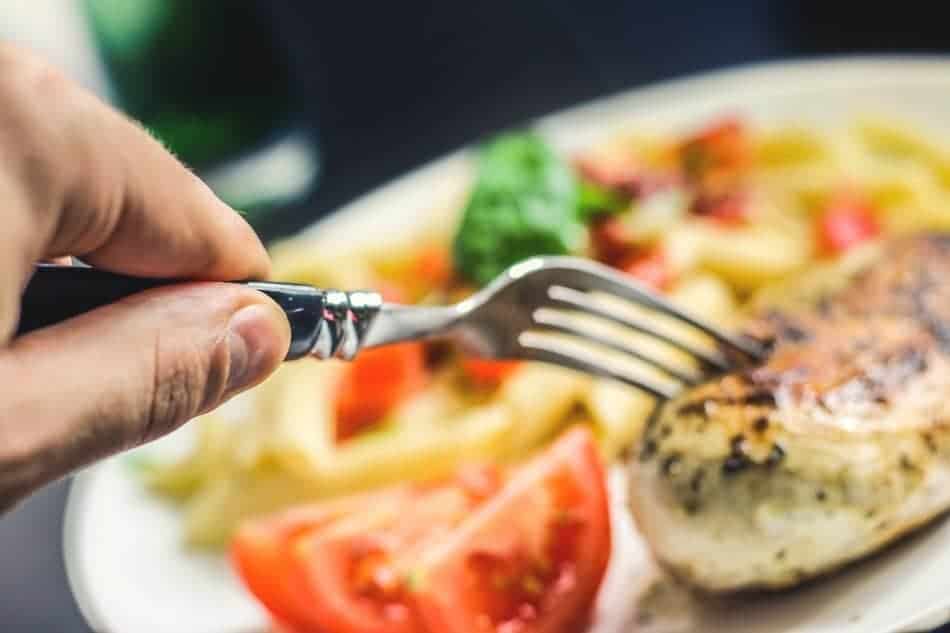
One meal a day has received a lot of attention in the last couple of years due to its effectiveness in weight loss results. However, one of the most frequently asked questions is what to do when hungry on OMAD?
In general, there are several things you can do when you’re hungry on OMAD. Those are eating slowly, putting your fork down between bites, drink a lot of water, take a spoonful of MCT oil, and choose more satisfying foods.
In this article, I want to give you the best methods that will let you control your hunger.
What Exactly is Physical Hunger?
According to the dictionary, physical hunger means “a feeling of discomfort or weakness caused by lack of food, coupled with the desire to eat”. This is the feeling when the body sends the signal that is time to eat.
Physical hunger is different from emotional or psychological hunger. It’s the result of the elevation of certain hormones in the body (ghrelin) after not eating for a period of time (Pradhan, Geetali, et al. 2013).
Emotional hunger is a psychological feeling that urges you to eat. This is the feeling when you want to eat, but you’re not truly physically hungry. Emotional hunger can be stimulated by several triggers like fear, stress, anger, or loneliness.
In other words, it’s the mechanism that person chooses to use to cope with uncomfortable situations. Eating food stimulates digestion and parasympathetic response in the body. This process release feels good hormones like serotonin.
Over time, people who use food to feel better develop pattern adaptation which leads to habit formation. This means that each time when a stressful or uncomfortable situation raise, the body now has a mechanism in place to reduce stress – eating food.
They eat when they feel excited, they eat when they feel sad, and anything in between. For them, food is like a vehicle to get out from the uncomfortable emotions and feel “normal” again. They know overeating is bad. But they still do it.
How to recognize physical hunger? In general, you can recognize physical hunger by the sensation in the gut. The stomach feels empty and your energy may slow down. Some people also feel shaky, weak, easily irritated, and hard to maintain focus.
Why Am I so Hungry on OMAD?
People who are feeling hungry on OMAD may not fully understand the difference between physical and emotional hunger. Reducing food volume to one meal a day can feel uncomfortable, espeically for people who use food to comfort their emotions.
If someone who has been using food as a way to reduce stress for a very long time and now is doing intermittent fasting, it takes away a previously well-established comfort mechanism to deal with problems.
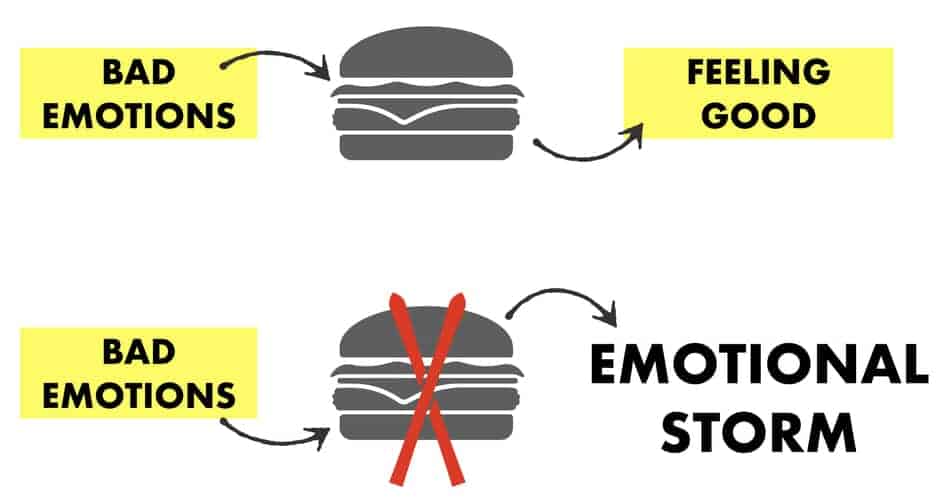
How Do You Tell if You’re Hungry or just Bored?
You can tell if you’re hungry or just bored by having a strong self-awareness about your internal body cues. Hunger usually builds up gradually several hours after your last meal. Psychological hunger from boredom strikes suddenly, despite being full after a meal.
Here in the table below you can see the comparison of how you can identify hunger from boredom.
| Physical hunger | Emotional hunger |
|---|---|
| build up gradually starts in the gut hours after the last meal goes away after the meal leads to satisfaction | strikes suddenly starts in the head unrelated to time persist despite eating leads to shame or guilt |
As you can see, there is a big distinction between physical and emotional hunger. The only way to satisfy physical hunger is by eating food. Once you eat something, hunger goes away.
To help you understand this concept I will use an analogy of the car that runs on two separate tanks. Tank P and Tank E.
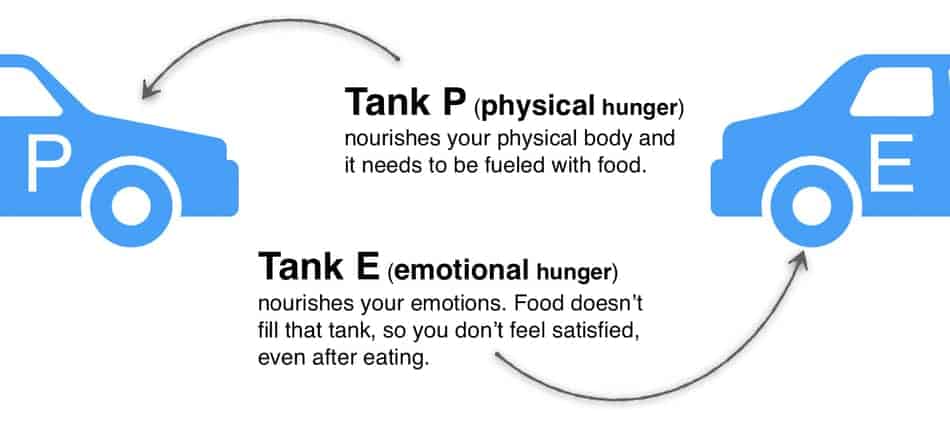
| Tank P | Tank E |
|---|---|
| physical hunger can only be fueled by food satisfied after the meal | emotional hunger can be only fueled by emotions and feelings satisfied after psychological needs are met |
The hunger that is coming from tank E tells you that some of your psychological needs aren’t effectively met. And no amount of food will be able to satisfy this hunger.
And when you’re using food as a way to muck up the emotions and feelings, you can’t really tell the difference between physical hunger and emotional hunger. So the only way to satisfy this signal is food. But this will only temporarily mask the discomfort.
It will take a lot of food to silence the emotional hunger. No food can fill up the Tank E, so you’re likely to feel hungry again soon.
You are still hungry on OMAD because you’ve haven’t eaten enough food, or you’re having emotional hunger because of the lack
How To Stop Hunger During OMAD
Feeling hungry during OMAD is normal because the body gets used to eating more frequent meals. However, there are several ways to stop feeling hungry.
#1: Recognize which hunger you feeling
Recognizing which hunger you’re facing will help to decide what sort of action you need to take. If you’re feeling bored or angry and you feel like you want to eat, then getting rid of boredom or changing your emotional state can help to eliminate emotional hunger.
Things that can help with emotional hunger include:
- meditation
- reading books
- walk with the dog
- strenuous exercise
- hobby
- social interactions
Those are all great way to regulate emotions, without raiding the refrigerator.
#2: Choose protein-rich food
Eating proteins on OMAD can help to reduce hunger because of protein-induced satiety. Elevated levels of amino acid concentration lead to greater anorexigenic response (loss of appetite). High protein intake also leads to increased thermogenesis, which influences satiety.
This means you stay fuller for longer and can reduce food cravings even when you’re not eating. In contrast, eating high-fat foods leads to higher appetite and lower satiety levels because of their high energy density and palatability (Veldhorst, M et al. 2008).
However, some fats that have MCT structure seems to have better satiety effects than others.
#3: Use MCT oil
Taking MCT oil or coconut oil can help to stop hunger on OMAD because medium-chain triglycerides are hydrolyzed and absorbed directly by the liver. This impacts hunger because satiety is associated with increased fatty acid oxidation in the liver.
In other words, MCT oils are triggering the liver to signal an anorexigenic response that keeps you full. And because they bypass the general digestion, they do not cause insulin to raise. Which means they can be taken during the fasting window (Langhans, 1996).
#4: Use green tea extract
Green tea extract can help not to feel hungry on OMAD because it reduces satiety when consumed together with meals. Green tea has bioactive phytochemicals that help to suppress appetite and helps to reduce food cravings, especially at the beginning of the OMAD.
Several studies have shown that herbal compounds extracted from green tea and yerba mate (e.g. catechins) are helpful in inducing satiety, increasing thermogenesis, and stimulating ghrelin. All of those effects lead to lower food cravings (Astell, Katie J et al. 2013).
#5: Exercise daily
Exercise can help during OMAD to stop feeling hungry because it influences the control of appetite. Single session of any form of exercise facilitate a short-term energy deficit and appetite-related hormone responses, which leads to greater satiety.
Studies have shown that “single sessions of exercise suppress circulating concentrations of acylated ghrelin during aerobic exercise at intensities above 60% VO2 peak” (Broom, D R et al. 1985).
This means going out for a brisk walk, going a spin class or doing any form of exercise of your choice can help to kill the hunger pangs.
#6: Drink coffee
Drinking coffee throughout the day while doing OMAD can help to stop hunger pangs because of caffeine, and its effects on gastric emptying and appetite hormones. Also, decaffeinated coffee can acute effect on decreasing hunger and increasing the satiety hormone PYY.
Also, studies show that people who drink caffeine during their weight loss program experienced a lesser reduction in the resting energy expenditure that usually happens with reduced body weight.
When you’re losing weight, the body will lower metabolism due to lower body mass. This lowers metabolic rate and calories burned. Caffeine has been shown to keep the resting metabolic rate higher, comparing to control groups (Westerterp-Plantenga, Margriet S, et al. 2005).
#7: Get some chewing gum
Chewing sweetened gum can help to lower the hunger on OMAD because chewing gum increases your energy expenditure and can significantly suppress cravings for snacks. Studies have shown that intermittently chewing gum after the meal enhances perception of satiety.
This has a massive impact over a long time because it can be used as a simple strategy to lower the cravings as they appear. In the study on 50 people, the group who chewed gum during the day managed to reduce the total energy intake by 9.3% (Park, Eunyoung et al. 2016)
#8: Slow down your eating
Eating slowly can help you deal with your hunger during OMAD because it delays the time at which food enters the gut and increase ghrelin suppression. Slow eating can not only reduces the overall food intake but also extends the satiety time after the meal.
One of my clients, Frank, told me at the beginning when we started working together that he is very skeptical about hiring a trainer. He used to go to the gym and sign up for the class where his ex-trainer ask him to do the same exercises as the rest of the groups.
Remember that Frank is 64-year old guy that never trained in the gym before. Yet still, his trainer asked him to do all crazy exercises, just like everyone else in the group.
So when he came to me with that scratch, it was understandable why he didn’t trust me.
But he give it a shoot. And as a first practice I told him to eat slowly. He was flabbergasted. He thought that I was joking. But I took the time to explained him why is so important.
I’ve explained him that when he eat slowly, he must focus on purposeful chew his meal more that usual. That when before he takes his bite, to spend time on smelling and tasting the food.
I’ve told Frank that this will stimulate his enzymatic sequence, his gastric acid production, and his peristaltic mobility. In other words, by slowing down on his meal, he is communicating to his body to start producing satiety hormones.
This means he will feel fuller with less food.
It takes around 15-20 minutes for satiety to reach its peak. And to speed that up you want to smell and taste the food. Mindfully, on purpose.
If you don’t, if you just shovel the food down the pipeline, your body never really registers that you eat. So if your body doesn’t know that you’re eating, when do you gonna stop?
When it’s too late. When your stomach has reached full capacity and your feel like a balloon. He was listening.
I told him that slow eating will help him to tune in to the internal body signals. This is called interoception.
Interoception is the ability to sense everything that is within the body. Hunger, thirst, pain, discomfort, muscle tension, heart rate, tingling, etc.
And the thing is that when we use food as a coping mechanism, or when we are stressed out, or when we take some sort of medications, or when we are distracted and just basically disconnected from our inner signals, our body confuses those signals. It’s like an inner compass or GPS malfunction.
That’s why some people who get asked:
On a scale of 1 – 10, how intense was that workout?
Can you tell me which muscle did you feel the most after this exercise?
Is that a muscle or joint pain you’re currently feeling?
Is that an appetite or hunger you’re currently feeling?
Are you really hungry right now, or you just feel bored or lonely?
They don’t know. They can’t tell the difference. So eating slowly will start to recalibrate this inner compass.
He was shocked. And he decided to give it a try. he asked me of the exact steps what doesn’t it mean to eat slowly. So I gave him a simple checklist to follow. This is the checklist I gave to Frank.
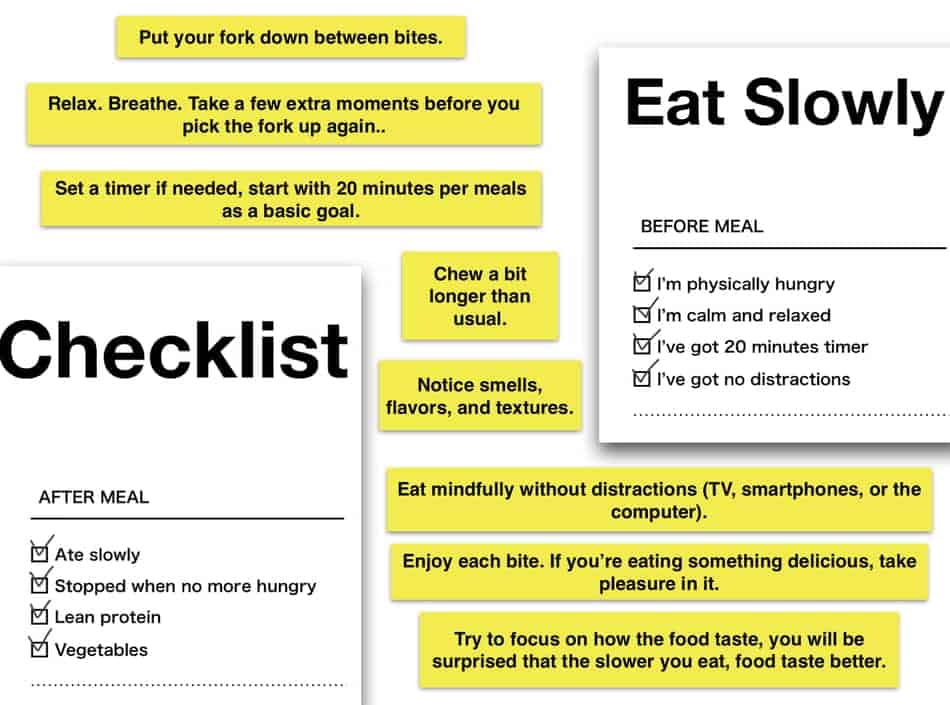
3 months later Frank lost 25 lb. He didn’t do one meal a day. He didn’t do any form of intermittent fasting. In fact, I’ve never even told him what to eat. I just told him how to eat.
All he did was eating slowly. Spending 20-minutes for his meal and following the checklist. I’ve helped hundreds of people by following the same protocol. So it works. It just needs a daily, conscious practice from your side.
#9: Eat when physically hungry
Once you get into grips with eating slowly you will notice a couple of things. First, you will be able to easily distinguish physical hunger from emotional hunger. That is by far the most valuable lesson you can get. You will be able to know if you’re really hungry, or is this something else.
You can use another checklist for this. It’s called appetite and cravings tracker. You can use that before your meals. Also, feel free to write stuff down that you’re thinking around your mealtime. Just like a journal.
This will help you identify not only what you feel but what are you thinking swell. You may discover things like:
Whenever I’m thinking about X I feel like I need to eat.
Whenever I’m with X person I feel like eating more.
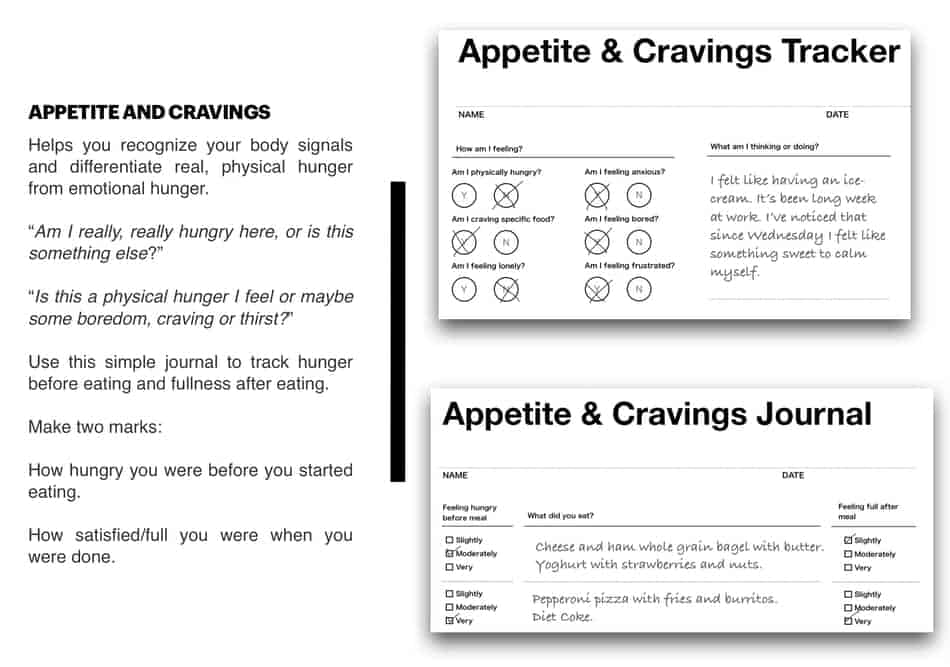
None of the diets will teach you this skill. Because once you can realize how exactly physical hunger feels and how appetite or cravings feels, you are in control of so much more.
Another checklist you can use is the pre-flight checklist. This will help you to remember some of the basics and stay on top of your game.
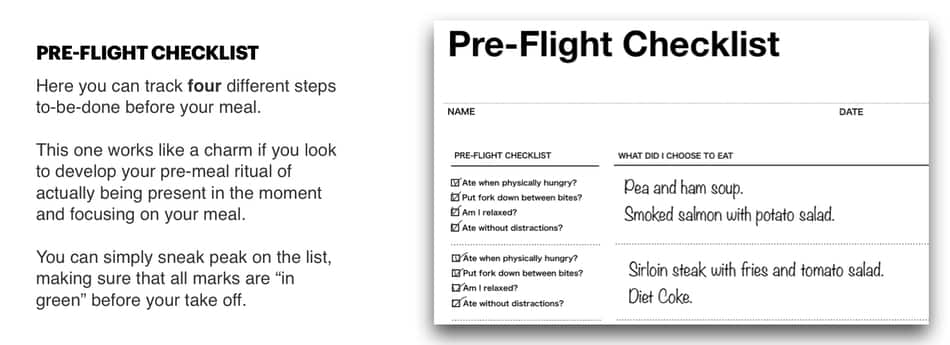
Second, once you know when you’re physically hungry, now you can use that and start eating when your Tank P is running out of fuel. You will be able to differentiate any emotional whiff from the actual physical hunger and you won’t freak out.
Third, you will realize that actual, physical hunger is not an emergency. Is just a feeling. And it doesn’t just build up like a skyscraper. It comes and goes.
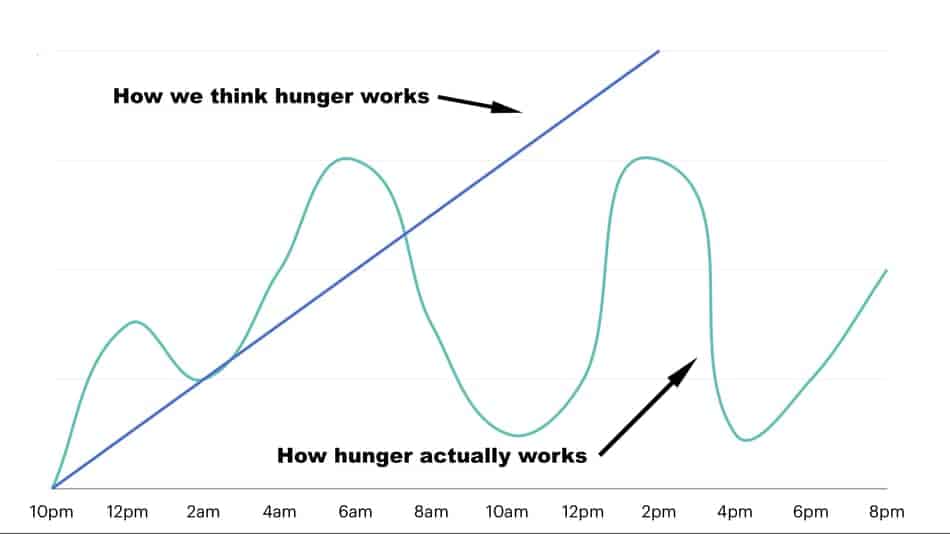
Physical hunger is a signal that you can sense, depending on the levels of a hormone called ghrelin. And the good news is that those hormones fluctuate.
And just because you feel hungry now, it doesn’t mean you will feel hungrier later. So knowing when you’re physically hungry will allow you to stop eating when you feel no longer hungry.
#10: Stop eating when you’re no longer hungry
The next step with dealing with hunger on OMAD is to stop eating when no longer hungry. This is the pinnacle of body awareness. Being able to really sense your body cues and feel when you’re no longer hungry will transform your relationship with food like no tomorrow.
A study was done by Brian Wansink Ph.D., former director of the USDA’s Center for Nutrition Policy and Promotion, where he documented that Americans use more external cues to know when to finish eating (Wansink, Brian et al. 2007).
For instance, they will stop eating when the TV show is over, when they finish everything from the plate or when they run out of beverage.
On the other hand, Europeans use more internal cues. For instance, they stop eating when they are no longer hungry.
What does it mean no longer hungry? It means that you are finishing your meal when you’re satisfied or simply put 80% full. You do not keep on eating until you’re 100% full.
There is a simple practice you can do to get into grips with that. I call it hunger games. This checklist and journal help you to decide about when you’re starting your meal and when you’re finishing your meal.
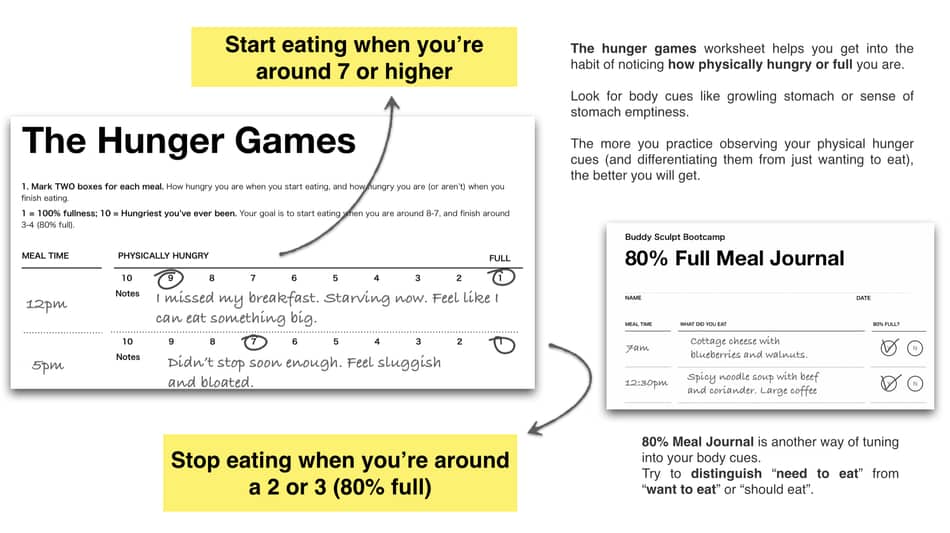
On a scale of 1 to 10, make 2 circles. The first circle is when you’re about to start your meal. Try to eat when you’re physically hungry, but not starving.
The second circle is when you’re about to finish your meal.
Don’t worry, it will take some time to practice. And now it may sound confusing, but once you start eating slowly, and get to know exactly how the hunger feels, this practice will hit home with you.
Another great exercise to practice meal cessation is post-game analysis. This practice is specifically designed to look at your meal at reminding yourself about the following.
You’ve eaten when physically hungry.
You’ve eaten mindfully without distractions.
You’ve stopped when satisfied.
You’ve eaten slowly for twenty minutes.
You choose foods that were satisfying.
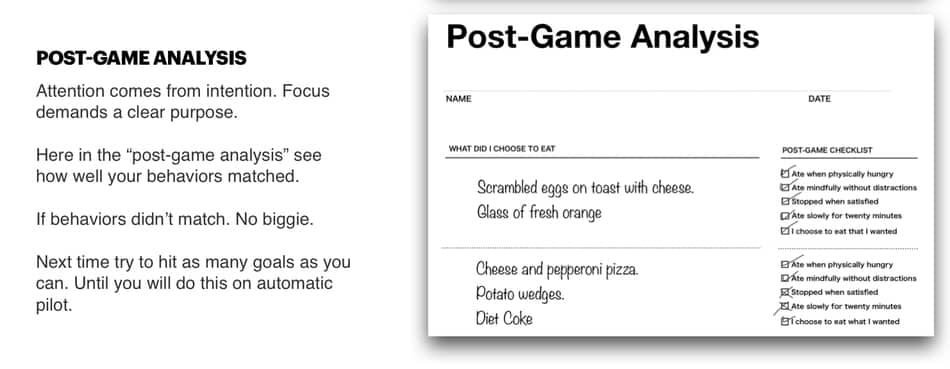
Remember that this will take time. So don’t set up ultra-high expectations on yourself. But it’s worth it.
When you get in to know your body signals, you will be able to stay in control and know how to stop hunger during OMAD. Even if you one day decide that one meal a day is not for you anymore.
That’s fine.
Because guess what. Now you have a skill. Now you can be on any diet and still be able to maintain your results. Historically people were losing weight on any diet. Doesn’t matter if a paleo, keto, or carnivore diet.
Is OMAD Starvation?
OMAD is not starvation. It is a form of intermittent fasting where you eat one meal a day on a daily, weekly, or biweekly basis, for a limited time. It creates a negative energy balance, and people who use the word starvation, usually exaggerate their discomfort from feeling hungry.
We all do it.
Remember when last time you had this feeling that you felt you could eat a horse? Maybe you started your day feeling rushed where you didn’t have time for breakfast. And because you’re so busy during lunchtime, all you had time for was a coffee and a muffin.
So by the time you get home, you feel like you could eat a horse. That is normal. That discomfort in the stomach is the feeling of hunger. But it’s not an emergency.
I used to believe that any discomfort in my tummy is a red flag. And grumblings and noises I hear this is a sign is a time to eat. And if I haven’t eaten for the whole day that means I’m starving.
Big mistake.
The term “starvation mode” is popularly used by us daily to exaggerate, and to describe a physiological state that happens during caloric deficit (aka dieting). Those sounds and noises in the belly. This uncomfortable feeling when I haven’t eaten for a while (Kábrt, J et al. 1990).
On the other hand, the actual definition of starvation is different.
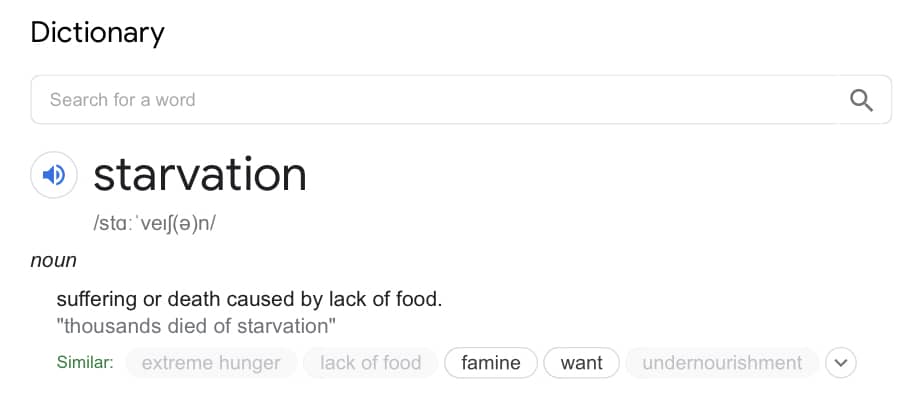
According to Wikipedia, starvation means suffering or death caused by a lack of food.
That is the actual, technical term for starvation. And we all have seen pictures of people from the WWII nazi camps who were starving.
Big difference.
It is easy to over-exaggerate when we’re emotional. We may feel stressed out and we say that we are starving. But in reality, we may be just a little bit hungry.
So one trick that I use with my clients is the self-evaluation check.
How To Be Less Hungry When Fasting?
To be less hungry when fasting, you can do an honest self-evaluation check that helps you to accurately assess how hungry you really are. People often amplify their feelings, where in reality may be less intense as they think they are.
It’s very basic. But it works like a charm. If a client tells me that she overeat on this particular day, I give her a self-evaluation assignment. Next time when you will find yourself in the same situation, ask yourself.
On a scale of 1 to 10 (where one is you are not hungry at all and 10 is you haven’t been eaten for days), how hungry you really are?
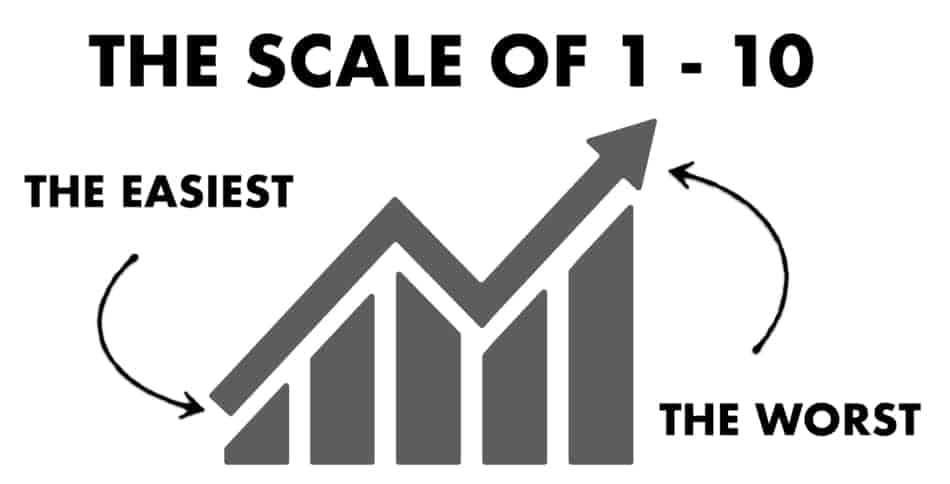
That’s it. Be honest with yourself. It’s like a reality check.
And simple question like that makes all of a sudden everything normal again. Clients report that they don’t actually feel that hungry. So as a result they relax and get their control back.
Which is essential if you want to stop over-eating. Because when we are high on emotions.
The belief of starvation mode is that will “slow down” or “damage” metabolism is dramatized. And short, 20-hour fast won’t make you look like Auschwitz Birkenau.
Take Away
When you look at all the diets in the past, they all share something in common. They all work if you do them over a long period of time.
But because they are usually restraining you from food that you like, the longer you stay restricted from those foods, the more your body crave them
So instead of looking at what diet is best, think about what all those diets have in common? They all work by caloric restriction. This means eating less food.
So by eating less food, doesn’t matter what diet you follow, you will be able to lose weight. That’s why eating slowly, eating when you physically hungry, and stop eating when satisfied will give you the skills to not be hungry, lose weight, and maintain your results, regardless of the diet you are on.
Go Further with OMAD
This article is part of the How To Do OMAD, which I recommend you read.
In the following pages, I show you all the related aspects necessary to design and personalize your intermittent fasting approach to fit into your lifestyle.
Next: Click here to learn more about can you do omad everyday
